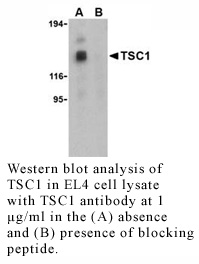Anti-Human Tuberous Sclerosis Complex 1 (Intermediate Domain) (T
Data
- -
- -
Antibody DetailsProduct DetailsReactive Species Human Host Species Rabbit Product Concentration 0.5 mg/ml Formulation This polyclonal antibody is formulated in phosphate buffered saline (PBS) pH 7.4 containing 0.02% sodium azide as a preservative. Storage and Handling This polyclonal antibody is stable for at least one week when stored at 2-8°C. For long term storage, aliquot in working volumes without diluting and store at –20°C in a manual defrost freezer. Avoid Repeated Freeze Thaw Cycles. Country of Origin USA Shipping Next Day Ambient RRIDAB_2831889 Each investigator should determine their own optimal working dilution for specific applications. See directions on lot specific datasheets, as information may periodically change. DescriptionDescriptionSpecificity Rabbit Anti-Human Tuberous Sclerosis Complex 1 (TSC1) recognizes an epitope in the intermediate domain of Human, Mouse and Rat TSC1. This polyclonal antibody was purified using affinity chromatography. Background Tuberous sclerosis complex (TSC) is an autosomal dominant tumor syndrome caused by mutations in either of the TSC1 or TSC2 tumor suppressor genes. The products of these genes form a protein complex that indirectly decreases the signaling of the mammalian Target of Rapamycin (TOR), an evolutionarily conserved serine/threonine kinase that regulates cell growth and cell cycle through its ability to integrate signals from nutrient levels and growth factors (reviewed in 1,2). TOR activity is stimulated by Rheb, a member of the Ras superfamily of G-proteins, when the GTP/GDP ratio bound to Rheb is high.3 Immunoprecipitated TSC1/TSC2 has been shown to stimulate Rheb GTPase activity in vitro,4 suggesting that the TSC1/TSC2 decreases the ability of Rheb to stimulate TOR activity. This is supported by experiments showing overexpression of TSC1 and TSC2 results in a significant decrease in the GTP/GDP ratio bound to Rheb and the inhibition of cell growth.4 A shorter 40 kDa isoform of TSC1 has been shown to exist but its function is unknown. References & Citations1. Shamji, AF. et al. (2003) Mol. Cell 12:271 2. Inoki, K. et al. (2005) Mol. Biol. Rev. 69:79 3. Tabancay Jr., AP. et al. (2003) J. Biol. Chem. 278:39921 4. Inoki, K. et al. (2003) Genes Dev. 17:1829 Technical ProtocolsCertificate of Analysis |
Related Products
- -
- -
 Products are for research use only. Not for use in diagnostic or therapeutic procedures.
Products are for research use only. Not for use in diagnostic or therapeutic procedures.




